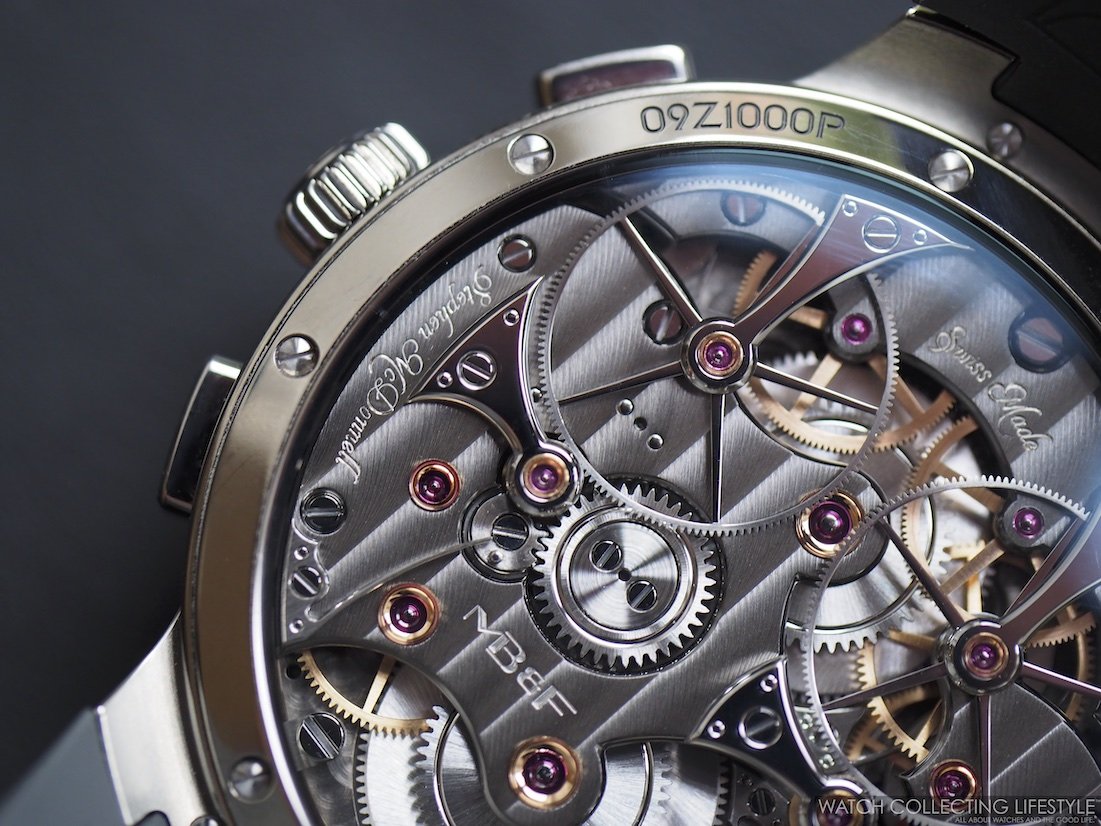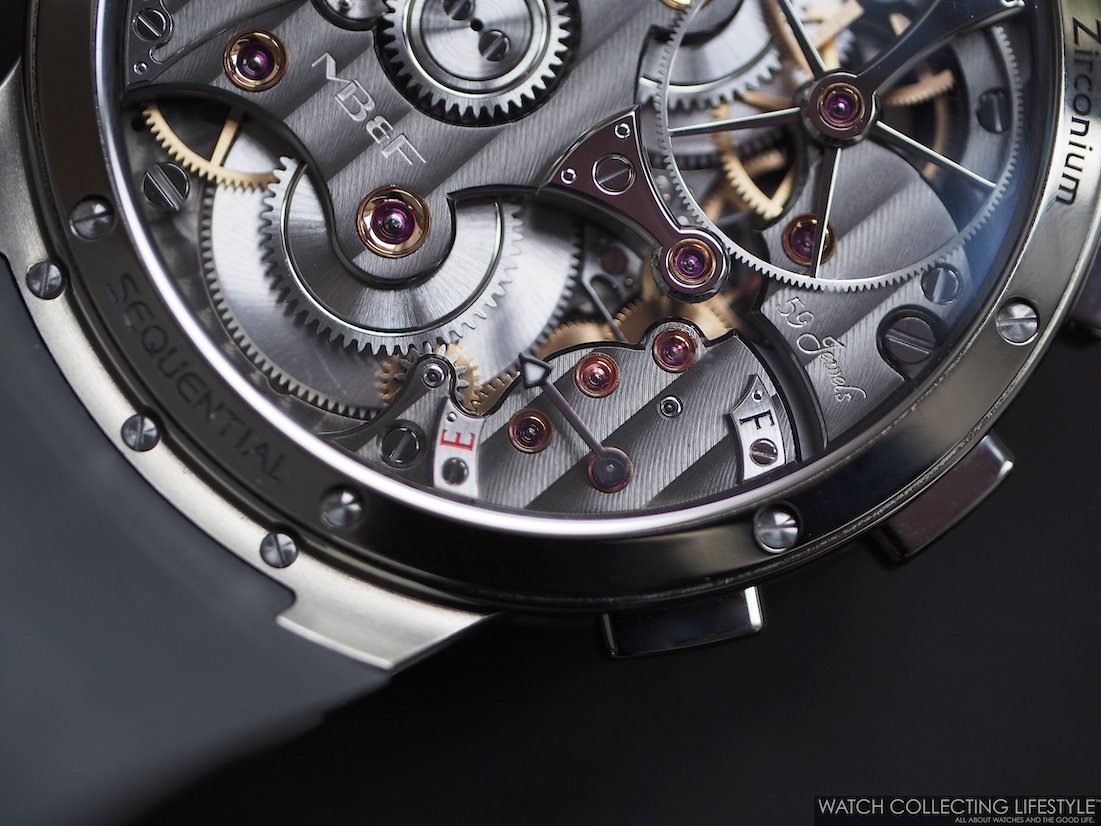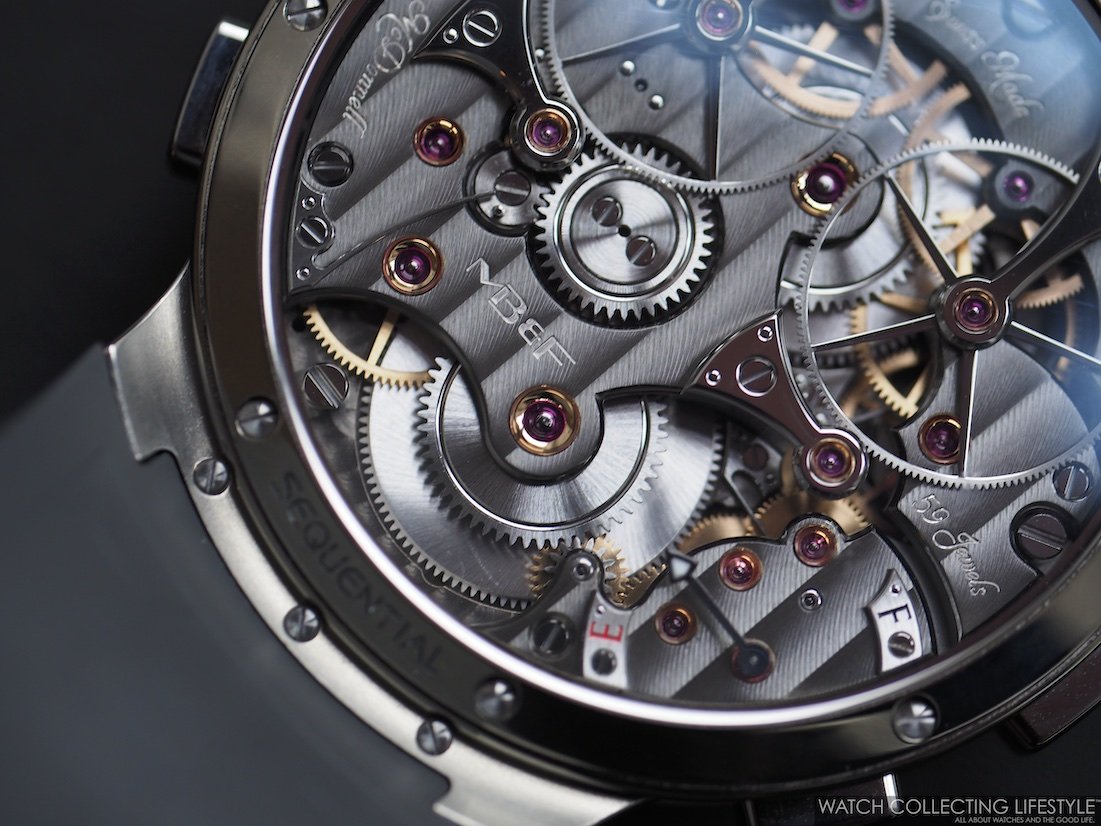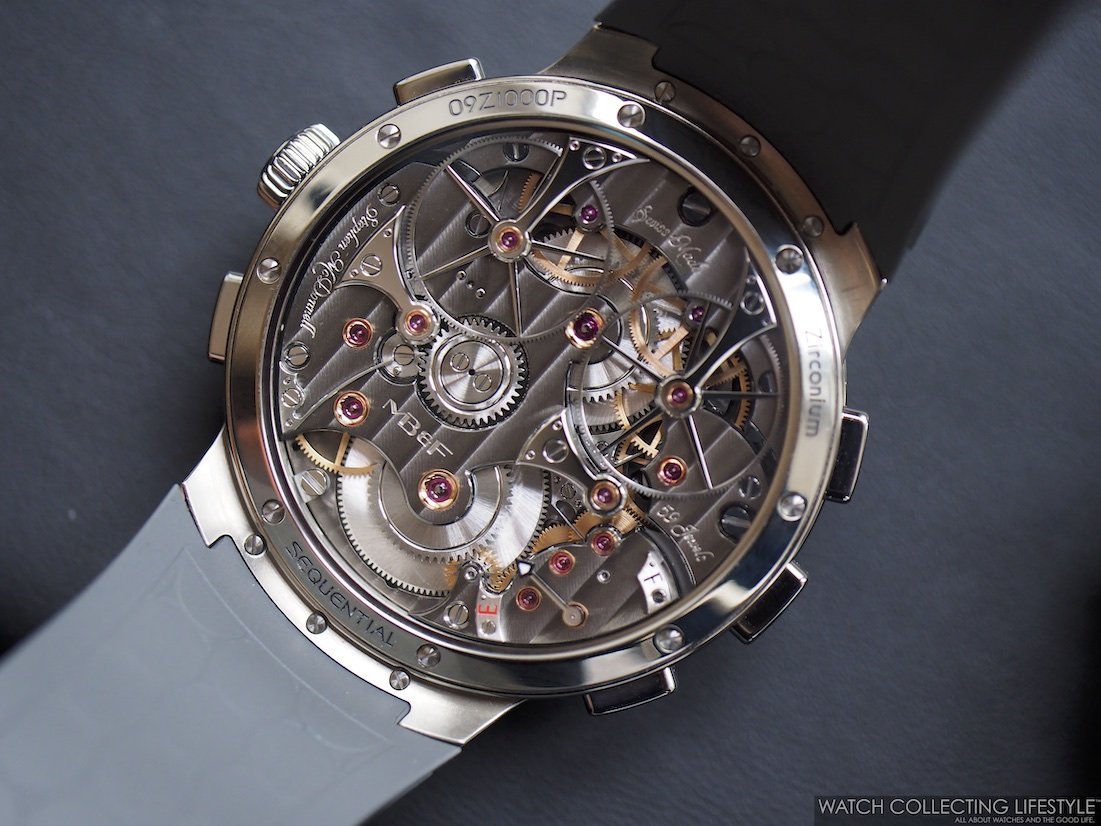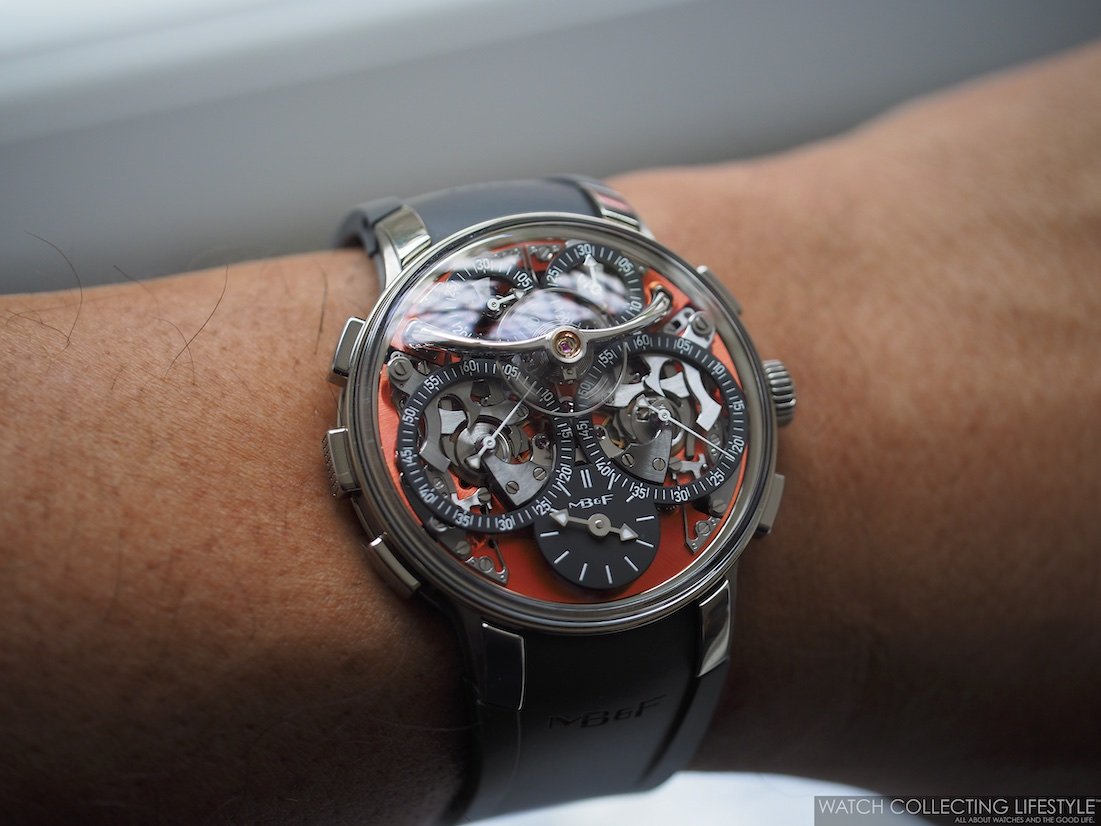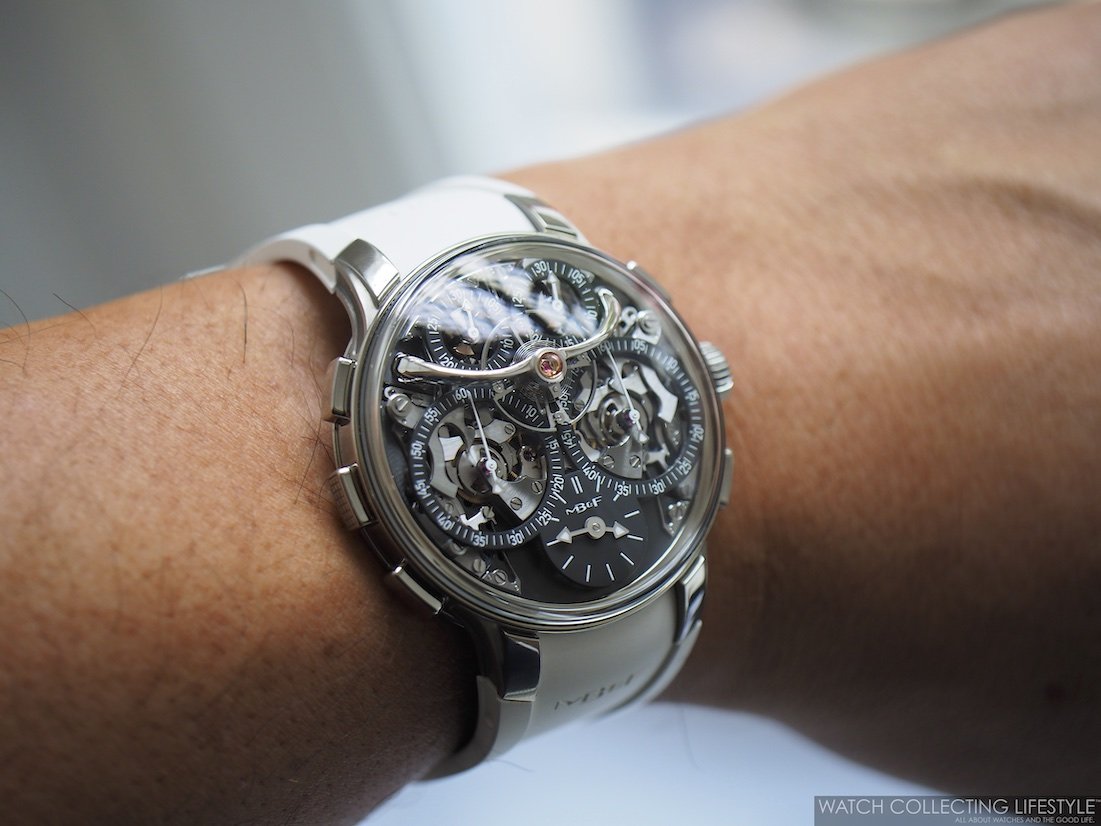Today, November 10th, 2022, MB&F has been awarded the Aiguille d’Or Grand Prix at the 2022 Grand Prix d’Horlogerie de Genève —GPHG. It took 17 years after the release of their first watch for MB&F to release their first chronograph and its 20th calibre. One movement with two chronographs and multiple timing modes. Conceived with Stephen McDonnell, who previously reinvented the LM perpetual calendar for MB&F, the Legacy Machine Sequential EVO movement incorporates two column-wheel chronographs and a groundbreaking “Twinverter” binary switch, allowing multiple timing modes including split-second and lap timer modes —a combination never seen before in any chronograph.
Cased in a generous 44 mm case in zirconium, the MB&F LM Sequential EVO explodes the current limits of what we thought chronographs could do. Just like the 2015 Legacy Machine Perpetual, the last major Stephen McDonnell movement for MB&F, LM Sequential EVO involved a back-to-the-drawing-board approach toward the most basic assumptions on chronograph construction.
The dial plate of LM Sequential EVO, available in atomic orange or coal black, features two chronograph displays. One has its seconds display at 9 o’clock and minutes display at 11 o’clock. The other has its seconds display at 3 o’clock and minutes display at 1 o’clock. Each of these chronograph displays can be started, stopped, and reset completely independently of each other, using the start/stop and reset pushers on their respective sides of the case. These make up the four chronograph pushers you would usually associate with having two chronograph mechanisms in one watch.
However, there is a fifth pusher, located at the 9 o’clock position referred to as the “Twinverter”. This pusher is the secret that elevates the functionality of the LM Sequential EVO beyond any existing chronograph wristwatch. It controls both chronograph systems, operating as a binary switch that inverts the current start/stop status of each chronograph. This means that if both chronograph displays happen to be stopped —at zero position or otherwise—, pressing the Twinverter will cause both of them to start simultaneously. If they are both running, the Twinverter makes them stop. If one is running and the other is stopped, the Twinverter stops the one that is running and starts the one that is stopped.
Additionally, the MB&F LM Sequential EVO can therefore be used just as you would any other chronograph, but thanks to its twin chronograph mechanisms, it can also perform the same functions as a split-seconds chronograph. In fact, thanks to the novel mechanical improvements to chronograph construction as conceived and implemented by Stephen McDonnell, it even outperforms conventional chronographs and split-seconds chronographs in terms of energy efficiency and precision.
But there’s much more: the switch function that comes with the Twinverter allows LM Sequential EVO to do things that no chronograph wristwatch, no matter how complicated, has been able to accomplish so far. Here are a few things that the LM Sequential EVO can do, that existing chronographs cannot:
Independent Mode can be used for instance in the preparation of a meal, where different things need to be cooked for different periods of time, at different points in time. You would operate the two chronograph mechanisms via their respective pushers —for instance, starting one when you put your pasta into boiling water and starting the other when the vegetables go in the oven. In fact, this application of LM Sequential EVO comes in handy in all areas of personal productivity. At the gym, for example, when trying to optimize your physical workout routine, one chronograph can be set to time your entire session whilst the second is used to record your time at each station, or the downtime in between.
Simultaneous Mode is used for example in a race involving two competitors, starting simultaneously. The Twinverter allows to start both chronographs at exactly the same time, but the different endpoints can be easily recorded by pressing each chronograph’s individual start/stop pusher. To note, the duration of the events can exceed 60 seconds, which is the limit for the vast majority of split-second chronographs on the market.
Cumulative Mode occurs frequently in the work environment, where you might want to know how much time you spend on two separate projects as you switch between them throughout the day. By starting one chronograph when you begin working on one task, and then using the Twinverter when you shift focus to the second task —switching again when you go back to the first—, you can easily track the amount of time you cumulatively spend on each task. Another example of this usage is the timing of a chess match.
Sequential Mode —or lap mode— has its greatest relevance in competitive sports, where it can be used to measure individual lap times. Starting one chronograph at the beginning of an event and using the Twinverter upon the completion of a lap instantly launches the second chronograph in order to time the next lap, while the first chronograph is stopped, allowing ample time for the timing result to be noted down. The stopped chronograph can then be reset to zero, ready to be relaunched with the Twinverter for the following lap. Thanks to its minutes’ totalizers, LM Sequential EVO can be used effectively in sporting events with average lap times of over a minute —which includes the vast majority of lap-racing sports.
Most other high-concept chronographs that are designed to increase the uses of the chronograph go about it by tailoring the mechanism towards highly specific, sports-oriented situations. In comparison, LM Sequential EVO operates in every aspect of daily life, in contexts familiar to all of us. Its zirconium case, 80 meters of water resistance, and internal “FlexRing” damping system give unprecedented resilience to a movement this complex.
The Movement
The movement powering the Legacy Machine Sequential EVO is the 20th calibre developed by MB&F. Composed of 585 components, this manual wound movement is a fully integrated dual chronograph system developed for MB&F by Stephen McDonnell, featuring a Twinverter switch allowing multiple timing modes. Fitted with a double mainspring, the movement provides a power reserve of 3 days when fully wound. The movement features a convenient power reserve indicator visible on the backside.
When Maximilian Büsser spoke to Stephen McDonnell in 2016, raising the possibility of a follow-up to Legacy Machine Perpetual released in 2015, the response from Stephen was four words long: “I have an idea.” It was a response as cryptic as it was exciting, particularly if you knew the kind of ideas that came from the mind of Stephen McDonnell. The combined chronograph lever immediately suggested itself to him as a way to ensure that race events could be measured with maximum precision with a manually operated mechanical chronograph. Allowing the chronograph systems to be operated separately meant that different timings could be taken and preserved long enough for the results to be recorded.
From then on, the various solutions fell into place. Using two separate chronograph mechanisms linked to the same oscillator —an idea practically made for the Legacy Machine, with its central flying balance wheel— meant that timing errors due to tiny chronometric discrepancies between different timers would be eliminated. Stephen McDonnell continued to refine his vision of the ideal chronograph, reconfiguring the chronograph vertical clutch to sit within the main gear train in order to eliminate the infamous flutter of the chronograph seconds hand without the need for an amplitude-draining friction spring. He incorporated internally jeweled chronograph clutch shafts that would make amplitude fluctuation between the active and inactive modes of the chronograph a thing of history.
The crowning touch to Stephen McDonnell’s ideal chronograph, augmenting the role played by the combined starting lever in historical chronograph systems, is the Twinverter concept. The ability to toggle instantly between chronograph operating modes directly opens up this age-old complication to be used in a variety of situations in modern daily life. It is the programming logic gate of mechanical watchmaking, a system that could have been devised only by the creator of the mechanical processor at the heart of Legacy Machine Perpetual.


















